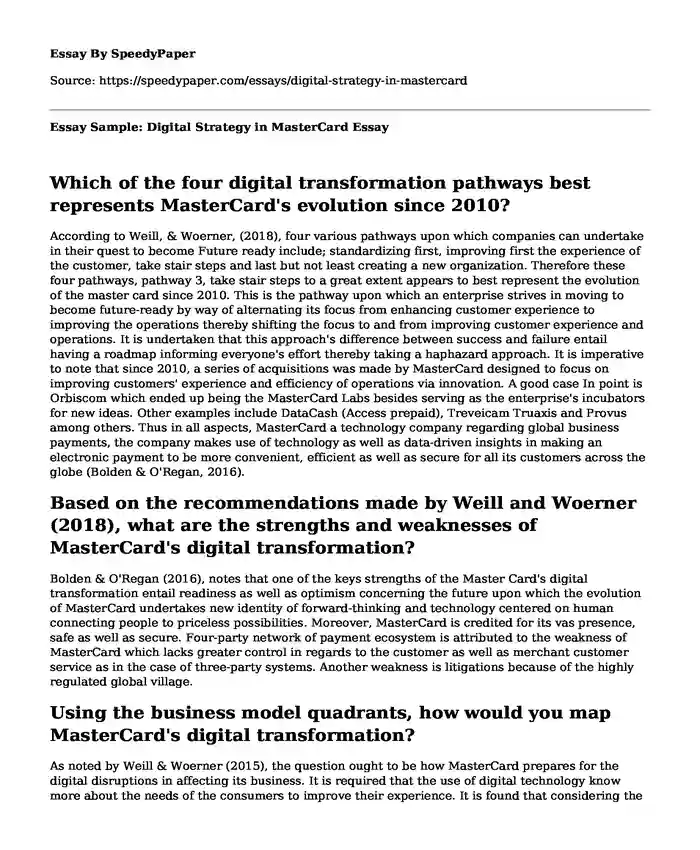
| Type of paper: | Essay |
| Categories: | Strategic marketing |
| Pages: | 3 |
| Wordcount: | 637 words |
Which of the four digital transformation pathways best represents MasterCard's evolution since 2010?
According to Weill, & Woerner, (2018), four various pathways upon which companies can undertake in their quest to become Future ready include; standardizing first, improving first the experience of the customer, take stair steps and last but not least creating a new organization. Therefore these four pathways, pathway 3, take stair steps to a great extent appears to best represent the evolution of the master card since 2010. This is the pathway upon which an enterprise strives in moving to become future-ready by way of alternating its focus from enhancing customer experience to improving the operations thereby shifting the focus to and from improving customer experience and operations. It is undertaken that this approach's difference between success and failure entail having a roadmap informing everyone's effort thereby taking a haphazard approach. It is imperative to note that since 2010, a series of acquisitions was made by MasterCard designed to focus on improving customers' experience and efficiency of operations via innovation. A good case In point is Orbiscom which ended up being the MasterCard Labs besides serving as the enterprise's incubators for new ideas. Other examples include DataCash (Access prepaid), Treveicam Truaxis and Provus among others. Thus in all aspects, MasterCard a technology company regarding global business payments, the company makes use of technology as well as data-driven insights in making an electronic payment to be more convenient, efficient as well as secure for all its customers across the globe (Bolden & O'Regan, 2016).
Based on the recommendations made by Weill and Woerner (2018), what are the strengths and weaknesses of MasterCard's digital transformation?
Bolden & O'Regan (2016), notes that one of the keys strengths of the Master Card's digital transformation entail readiness as well as optimism concerning the future upon which the evolution of MasterCard undertakes new identity of forward-thinking and technology centered on human connecting people to priceless possibilities. Moreover, MasterCard is credited for its vas presence, safe as well as secure. Four-party network of payment ecosystem is attributed to the weakness of MasterCard which lacks greater control in regards to the customer as well as merchant customer service as in the case of three-party systems. Another weakness is litigations because of the highly regulated global village.
Using the business model quadrants, how would you map MasterCard's digital transformation?
As noted by Weill & Woerner (2015), the question ought to be how MasterCard prepares for the digital disruptions in affecting its business. It is required that the use of digital technology know more about the needs of the consumers to improve their experience. It is found that considering the development of a digital ecosystem besides partnering with others as being paramount. The figure below shows four models of the business regarding the era of digital upon which the digital transformation of MasterCard would map the Ecosystem driver, because of the need of having complete knowledge of end consumer and business design being an ecosystem.
Based on the Mastercard card, what are the fundamental strengths and the key weakness of the Weill and Woerner (2017) framework?
The main strength of Weill and Woerner's (2017) framework entails its precise explanation regarding resources, capabilities as well as management choices paramount in responding to a given new environment. The weakness is in regards to the manner by which the framework tends to abstract complexities thereby isolating the only few variables hence generalization.
References
Andriole, S. J. (2017). Five myths about digital transformation. MIT Sloan Management Review, 58(3).
Bolden, R., & O'Regan, N. (2016). Digital disruption and the future of leadership: An interview with Rick Haythornthwaite, Chairman of Centrica and MasterCard. Journal of Management Inquiry, 25(4), 438-446.
Weill, P., & Woerner, S. L. (2018). Is Your Company Ready for a Digital Future?. MIT Sloan Management Review, 59(2), 21-25.
Weill, P., & Woerner, S. L. (2015). Thriving in an increasingly digital ecosystem. MIT Sloan Management Review, 56(4), 27.
Cite this page
Essay Sample: Digital Strategy in MasterCard. (2022, Nov 08). Retrieved from https://speedypaper.com/essays/digital-strategy-in-mastercard
Request Removal
If you are the original author of this essay and no longer wish to have it published on the SpeedyPaper website, please click below to request its removal:
- Essay Example: Impact of Physical Activity on the Respiration
- Graduate School Admission - Recommendation Letter Example for Free
- Free Essay on Paleolithic Diet
- The Nature of Perception, Marketing Essay Example
- Free Essay Comprising a Participant Observation of a Subculture - Music Producers
- The Hound of Baskerville - Free Essay in English Literature
- Essay Sample on Social Actions
Popular categories




